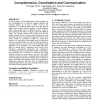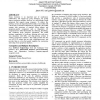GROUP
2003
ACM
14 years 5 months ago
2003
ACM
In order to support co-located collaboration, many researchers are now investigating how to effectively augment tabletops with electronic displays. As far back as 1988, orientatio...
GROUP
2003
ACM
14 years 5 months ago
2003
ACM
Although the Internet provides powerful tools for social interactions, many tasks—for example, information-seeking—are undertaken as solitary activities. Information seekers a...
GROUP
2003
ACM
14 years 5 months ago
2003
ACM
Group awareness is an important part of synchronous collaboration, and support for group awareness can greatly improve groupware usability. However, it is still difficult to build...
GROUP
2003
ACM
14 years 5 months ago
2003
ACM
Patterns, which are based on in-depth practical experience, can be instructing for the design of groupware applications as sociotechnical systems. On the basis of a summary of the...
GROUP
2003
ACM
14 years 5 months ago
2003
ACM
In this paper we describe a current group configuration that is used to support people with cognitive disabilities (hereinafter referred to as “clients”) in the workplace. A c...
GROUP
2003
ACM
14 years 5 months ago
2003
ACM
Telepointers are an important type of embodiment in real-time distributed groupware. Telepointers can increase the presence of remote participants and can provide considerable awa...
GROUP
2003
ACM
14 years 5 months ago
2003
ACM
This paper presents a study of an organisation, which is undergoing a process transforming organisational and technological boundaries. In particular, we shall look at three kinds...
GROUP
2003
ACM
14 years 5 months ago
2003
ACM
We describe a new collaborative technology that is mid-way between the informality of email and the formality of shared workspaces. Email and other ad hoc collaboration systems ar...
GROUP
2003
ACM
14 years 5 months ago
2003
ACM
Data are a fundamental component of science and engineering work, and the ability to share data is critical to the validation and progress of science. Data sharing and reuse in so...
GROUP
2003
ACM
14 years 5 months ago
2003
ACM






